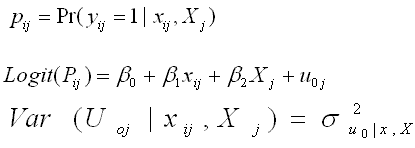
Multilevel modelling allows us to combine variables from survey data with aggregate data from another
source. Hence in the current example we could extend, for example, Model 3 to include aggregate
(country
level) information from another source. We illustrate this in Section 5 when we combine ESS survey
data
by adding % long term unemployment as an additional explanatory variable. This information is from
the
aggregate Eurostat New Cronos data. As this is country level information based on a census of all
economically active people (i.e. it is a census not a survey) we denote it as uppercase  . Note that there is only a j
(country level) subscript. There is no i subscript for this variable as all people in country
i
have the same value of long term unemployment. The substantive reason for adding long term
unemployment
here is that this may explain some of the country level variations in voting. Perhaps people living
in
countries with higher long term unemployment are more likely to vote. We will investigate this
later.
. Note that there is only a j
(country level) subscript. There is no i subscript for this variable as all people in country
i
have the same value of long term unemployment. The substantive reason for adding long term
unemployment
here is that this may explain some of the country level variations in voting. Perhaps people living
in
countries with higher long term unemployment are more likely to vote. We will investigate this
later.



